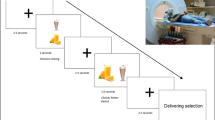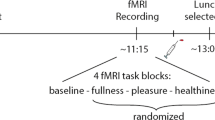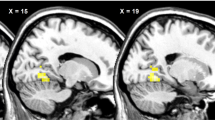Abstract
Objective:
Large portions of energy-dense foods drive energy intake but the brain mechanisms underlying this effect are not clear. Our main objective was to investigate brain function in response to food images varied by portion size (PS) and energy density (ED) in children using functional magnetic resonance imaging (fMRI).
Methods and design:
Blood-oxygen-level-dependent (BOLD) fMRI was completed in 36 children (ages 7–10 years) after a 2-h fast while viewing food images at two levels of PS (Large PS, Small PS) and two levels of ED (High ED, Low ED). Children rated perceived fullness pre- and post-fMRI, as well as liking of images on visual analog scales post-fMRI. Anthropometrics were completed 4 weeks before the fMRI. Large PS vs Small PS and High ED vs Low ED were compared with region-of-interest analyses using Brain Voyager v 2.8.
Results:
Region-of-interest analyses revealed that activation in the right inferior frontal gyrus (P=0.03) was greater for Large PS vs Small PS. Activation was reduced for High ED vs Low ED in the left hypothalamus (P=0.03). Main effects were no longer significant after adjustment for pre-fMRI fullness and liking ratings (PS, P=0.92; ED, P=0.58).
Conclusion:
This is the first fMRI study to report increased activation to large portions in a brain region that is involved in inhibitory control. These findings may contribute to understanding why some children overeat when presented with large portions of palatable food.
This is a preview of subscription content, access via your institution
Access options
Subscribe to this journal
Receive 12 print issues and online access
$259.00 per year
only $21.58 per issue
Buy this article
- Purchase on Springer Link
- Instant access to full article PDF
Prices may be subject to local taxes which are calculated during checkout


Similar content being viewed by others
References
Hill JO, Wyatt HR, Peters JC . The importance of energy balance. US Endocrinol 2013; 9: 27–31.
Kelly MT, Wallace JM, Robson PJ, Rennie KL, Welch RW, Hannon-Fletcher MP et al. Increased portion size leads to a sustained increase in energy intake over 4 d in normal-weight and overweight men and women. Br J Nutr. 2009; 102: 470–477.
Mathias KC, Rolls BJ, Birch LL, TVEE Kral, Hanna EL, Davey A et al. Serving larger portions of fruits and vegetables together at dinner promotes intake of both foods among young children. J Acad Nutr Diet 2012; 112: 266–270.
Orlet Fisher J, Rolls BJ, Birch L . Children’s bite size and intake of an entrée are greater with large portions than with age-appropriate or self-selected portions. Am J Clin Nutr 2003; 77: 1164–1170.
Kral TV, Kabay AC, Roe LS, Rolls BJ . Effects of doubling the portion size of fruit and vegetable side dishes on children’s intake at a meal. Obesity 2010; 18: 521–527.
Piernas C, Popkin BM . Food portion patterns and trends among U.S. children and the relationship to total eating occasion size, 1977-2006. J Nutr 2011; 141: 1159–1164.
Mooreville M, Davey A, Orloski A, Hannah EL, Mathias KC, Birch LL et al. Individual differences in susceptibility to large portion sizes among obese and normal-weight children. Obesity 2015; 23: 808–814.
English L, Lasschuijt M, Keller KL . Mechanisms of the portion size effect. What is known and where do we go from here? Appetite 2015; 88: 39–49.
Burger KS, Fisher JO, Johnson SL . Mechanisms behind the portion size effect: visibility and bite size. Obesity 2011; 19: 546–551.
Wansink B, Painter JE, North J . Bottomless bowls: why visual cues of portion size may influence intake. Obes Res 2005; 13: 93–100.
Olsen A, Ritz C, Kramer L, Møller P . Serving styles of raw snack vegetables. What do children want? Appetite 2012; 59: 556–562.
Reisfelt HH, Gabrielson G, Aasylng MD, Bjerre MS, Moller PER . Consumer preferences for visually presented meals. J Sens Stud 2009; 24: 182–203.
Rolls BJ, Ea Rowe, Rolls ET . How flavour and appearance affect human feeding. Proc Nutr Soc 1982; 41: 109–117.
Fisher JO, Liu Y, Birch LL, Rolls BJ . Effects of portion size and energy density on young children's intake at a meal. Am J Clin Nutr 2007; 86: 174–179.
Brooks SJ, Cedernaes J, Schiöth HB . Increased prefrontal and parahippocampal activation with reduced dorsolateral prefrontal and insular cortex activation to food images in obesity: a meta-analysis of fMRI studies. PLoS One 2013; 8: 4.
van der Laan LN, de Ridder DT, Viergever MA, Smeets PA . The first taste is always with the eyes: a meta-analysis on the neural correlates of processing visual food cues. Neuroimage 2011; 55: 296–303.
Bruce AS, Martin LE, Savage CR . Neural correlates of pediatric obesity. Prev Med 2011; 52: S29–S35.
van Meer F, van der Laan LN, Adan RA, Viergever MA, Smeets PA . What you see is what you eat: an ALE meta-analysis of the neural correlates of food viewing in children and adolescents. Neuroimage 2014; 104: 35–43.
Holsen LM, Zarcone JR, Thompson TI, Brooks WM, Anderson MF, Ahluwalia JS et al. Neural mechanisms underlying food motivation in children and adolescents. Neuroimage 2005; 27: 669–676.
Killgore WDS, Yurgelun-Todd DA . Developmental changes in the functional brain responses of adolescents to images of high and low-calorie foods. Dev Psychobiol 2005; 47: 377–397.
Atalayer D, Pantazatos SP, Gibson CD, McOuatt H, Puma L, Astbury NM et al. Sexually dimorphic functional connectivity in response to high vs low energy-dense food cues in obese humans: an fMRI study. Neuroimage 2014; 100: 405–413.
Dimitropoulos A, Tkach J, Ho A, Kennedy J . Greater corticolimbic activation to high-calorie food cues after eating in obese vs normal-weight adults. Appetite 2012; 58: 303–312.
Frank S, Laharnar N, Kullmann S, Veit R, Canova C, Hegner YL et al. Processing of food pictures: Influence of hunger, gender and calorie content. Brain Res 2010; 1350: 159–166.
Killgore WDS, Young AD, Femia LA, Bogorodzki P, Rogowska J, Yurgelun-Todd DA . Cortical and limbic activation during viewing of high- versus low-calorie foods. Neuroimage 2003; 19: 1381–1394.
Stoeckel LE, Weller RE, Cook EW 3rd, Twieg DB, Knowlton RC, Cox JE . Widespread reward-system activation in obese women in response to pictures of high-calorie foods. Neuroimage 2008; 41: 636–647.
Schur EA, Kleinhans NM, Goldberg J, Buchwald D, Schwartz MW, Maravilla K . Activation in brain energy regulation and reward centers by food cues varies with choice of visual stimulus. Int J Obes 2009; 33: 653–661.
Batterink L, Yokum S, Stice E . Body mass correlates inversely with inhibitory control in response to food among adolescent girls: an fMRI study. Neuroimage 2010; 52: 1696–1703.
Ely AV, Childress AR, Jagannathan K, Lowe MR . Differential reward response to palatable food cues in past and current dieters: a fMRI study. Obesity 2014; 22: E38–E45.
Beaver JD, Lawrence AD, van Ditzhuijzen J, Davis MH, Woods A, Calder AJ . Individual differences in reward drive predict neural responses to images of food. J Neurosci 2006; 26: 5160–5166.
Goldstone AP, Prechtl de Hernandez CG, Beaver JD, Muhammed K, Croese C, Bell G et al. Fasting biases brain reward systems towards high-calorie foods. Eur J Neurosci 2009; 30: 1625–1635.
Carnell S, Benson L, Pantazatos SP, Hirsch J, Geliebter A . Amodal brain activation and functional connectivity in response to high-energy-density food cues in obesity. Obesity 2014; 22: 2370–2378.
Bruce AS, Holsen LM, Chambers RJ, Martin LE, Brooks WM, Zarcone JR et al. Obese children show hyperactivation to food pictures in brain networks linked to motivation, reward and cognitive control. Int J Obes 2010; 34: 1494–1500.
Davids S, Lauffer H, Thoms K, Jagdhuhn M, Hirschfeld H, Domin M et al. Increased dorsolateral prefrontal cortex activation in obese children during observation of food stimuli. Int J Obes 2010; 34: 94–104.
Casey BJ, Tottenham N, Liston C, Durston S . Imaging the developing brain: what have we learned about cognitive development? Trends Cogn Sci 2005; 9: 104–110.
Geier CF, Terwilliger R, Teslovich T, Velanova K, Luna B . Immaturities in reward processing and its influence on inhibitory control in adolescence. Cereb Cortex 2010; 20: 1613–1629.
Raghubir P, Krishna A . Vital dimensions in volume perception: can the eye fool the stomach? J Mark Res 1999; 30: 313–326.
Brunstrom JM . The control of meal size in human subjects: a role for expected satiety, expected satiation and premeal planning. Proc Nutr Soc 2011; 70: 155–161.
Cole TJ, Bellizzi MC, Flegal KM, Dietz WH . Establishing a standard definition for child overweight and obesity worldwide: international survey. BMJ 2000; 320: 1240.
Keller KL, English LK, Fearnbach SN. But What is the Mechanism: Beyond Phenomena in the Study of Human Eating Behavior. Presidential Symposium, 23rd Annual Meeting of the Society for the Study of Ingestive Behavior Annual Meeting; Denver, CO, USA, 7-11 July 2015.
Smiciklas-Wright H, Mitchell DC, Mickle SJ, Goldman JD, Cook A . Foods commonly eaten in the United States, 1989-1991 and 1994-1996: are portion sizes changing? J Acad Nutr Diet 2003; 103: 41–47.
Knebel JF, Toepel U, Hudry J, le Coutre J, Murray MM . Generating controlled image sets in cognitive neuroscience research. Brain Topogr 2008; 20: 284–289.
Thesen S, Heid O, Mueller E, Schad LR . Prospective acquisition correction for head motion with image-based tracking for real-time fMRI. Magn Reson Med 2000; 44: 457–465.
Hare TA, Malmaud J, Rangel A . Focusing attention on the health aspects of foods changes value signals in vmPFC and improves dietary choice. J Neurosci 2011; 31: 11077–11087.
Brett M, Christoff K, Cusack R, Lancaster J . Using the Talairach atlas with the MNI template. Neuroimage 2001; 13: S85.
Tomasi D, Volkow ND . Functional connectivity of substantia nigra and ventral tegmental area: maturation during adolescence and effects of ADHD. Cereb Cortex 2012; 24: 935–944.
Dagher A . The neurobiology of appetite: hunger as addiction. Int J Obes 2009; 33 (Suppl 2): S30–S33.
Keller KL, Sa Assur, Torres M, Lofink HE, Thornton JC, Faith MS et al. Potential of an analog scaling device for measuring fullness in children: development and preliminary testing. Appetite 2006; 47: 233–243.
Talairach J, Tournoux P . Co-planar Stereotaxic Atlas of the Human Brain. Thieme: New York, USA, 1988.
Sanchez CE, Richards JE, Almli CR . Age-specific MRI templates for pediatric neuroimaging. Dev Neuropsychol 2012; 37: 379–399.
Burgund ED, Kang HC, Kelly JE, Buckner RL, Snyder AZ, Petersen SE et al. The feasibility of a common stereotactic space for children and adults in fMRI studies of development. Neuroimage 2002; 17: 184–200.
Benjamini Y, Hochberg Y . Controlling the false discovery rate: a practical and powerful approach to multiple testing. J R Stat Soc Ser B. 1995; 289–300.
Charbonnier L, van der Laan LN, Viergever MA, Smeets PA . Functional MRI of challenging food choices: forced choice between equally liked high- and low-calorie foods in the absence of hunger. PLoS One 2015; 10: e0131727.
Nakata H, Sakamoto K, Ferretti A, Gianni Perrucci M, Del Gratta C, Kakigi R et al. Somato-motor inhibitory processing in humans: an event-related functional MRI study. Neuroimage 2008; 39: 1858–1866.
Enax L, Hu Y, Trautner P, Weber B . Nutrition labels influence value computation of food products in the ventromedial prefrontal cortex. Obesity 2015; 23: 786–792.
Toepel U, Bielser M-L, Forde C, Martin N, Voirin A, le Coutre J et al. Brain dynamics of meal size selection in humans. Neuroimage 2015; 113: 133–142.
Brunstrom JM, Rogers PJ . How many calories are on our plate? Expected fullness, not liking, determines meal-size selection. Obesity 2009; 17: 1884–1890.
Cornier MA, Von Kaenel SS, Bessesen DH, Tregellas JR . Effects of overfeeding on the neuronal response to visual food cues. Am J Clin Nutr 2007; 86: 965–971.
Cornier MA, Salzberg AK, Endly DC, Bessesen DH, Rojas DC, Tregellas JR . The effects of overfeeding on the neuronal response to visual food cues in thin and reduced-obese individuals. PLoS One 2009; 4: e6310.
Masterson TD, Kirwan CB, Davidson LE, LeCheminant JD . Neural reactivity to visual food stimuli is reduced in some areas of the brain during evening hours compared to morning hours: an fMRI study in women. Brain Imaging Behav 2015; 10: 68–78.
Acknowledgements
This project was funded by the Social Science Research Institute at The Pennsylvania State University. The research personnel involved in this work are supported by the Childhood Obesity Prevention Training doctoral program funded by National Institute of Food and Agriculture, US Department of Agriculture award number no. 2011-67001-30117. We also thank the Penn State Social, Life, and Engineering Sciences Imaging Center (SLEIC), 3T MRI Facility.
Author information
Authors and Affiliations
Corresponding author
Ethics declarations
Competing interests
The authors declare no conflict of interest.
Additional information
Supplementary Information accompanies this paper on International Journal of Obesity website
Rights and permissions
About this article
Cite this article
English, L., Fearnbach, S., Lasschuijt, M. et al. Brain regions implicated in inhibitory control and appetite regulation are activated in response to food portion size and energy density in children. Int J Obes 40, 1515–1522 (2016). https://doi.org/10.1038/ijo.2016.126
Received:
Revised:
Accepted:
Published:
Issue Date:
DOI: https://doi.org/10.1038/ijo.2016.126



